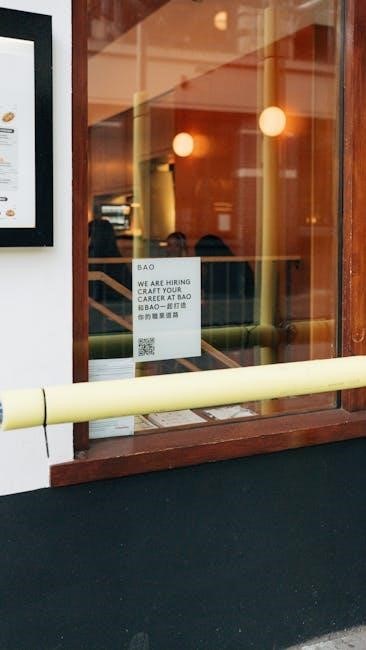A reference letter for employment is a document endorsing a candidate’s skills and character, crucial for job applications. It provides insights into their professional capabilities, verifying qualifications and work ethic.
What is a Reference Letter?
A reference letter, also known as a letter of recommendation, is a formal document written to endorse an individual’s qualifications, skills, and character for a specific purpose, such as employment or academic opportunities. Typically authored by a supervisor, colleague, or academic mentor, it provides an objective assessment of the candidate’s abilities and suitability for a role. The letter highlights the writer’s relationship with the candidate, their job responsibilities, and their personal qualities. It is usually written on official letterhead and includes the writer’s contact information for follow-up. A well-crafted reference letter can significantly enhance a candidate’s credibility and strengthen their application. It serves as a testament to their strengths and potential, offering insights beyond what is listed on a resume.
The Importance of Reference Letters in Job Applications
Reference letters play a crucial role in job applications by providing third-party validation of a candidate’s skills, work ethic, and character. Employers often rely on these letters to gain insights into a candidate’s past performance and potential to succeed in a new role. A strong reference letter can differentiate a candidate from others, especially in competitive job markets. It adds credibility to the claims made in a resume or cover letter, offering an objective perspective. Additionally, reference letters can highlight soft skills, such as teamwork or problem-solving, that are not always evident from other application materials. By building trust and confidence, a well-written reference letter can significantly influence hiring decisions.
Who Should Write a Reference Letter?
A reference letter should be written by someone who can speak confidently about the candidate’s skills, work ethic, and character. Ideally, it should come from a supervisor, manager, or colleague who has worked closely with the individual. Academic references from professors or academic advisors are also appropriate, especially for recent graduates. The person writing the letter should have a good understanding of the candidate’s strengths and achievements. It’s important to choose someone who can provide a genuine and detailed endorsement. Avoid asking friends or family members, as their opinions may lack professional credibility. Ensure the referee has firsthand experience working with the candidate to make the letter impactful.

Structure of a Sample Reference Letter for Employment
A sample reference letter for employment typically includes the sender’s contact information, date, recipient’s address, salutation, introduction, body detailing qualifications, achievements, and a concluding recommendation with contact information.
Key Components of a Reference Letter
A well-crafted reference letter for employment includes several essential components. First, it should begin with the sender’s contact information, including their name, position, company, and address. Next, the date and recipient’s details are provided. A clear subject line indicating the purpose of the letter is crucial. The introduction should state the sender’s relationship with the candidate and the nature of their interaction. The body should highlight the candidate’s skills, achievements, and qualifications, supported by specific examples. A personal touch, such as a brief anecdote, can add depth. Finally, the letter should conclude with a strong recommendation and an invitation for further inquiries. These elements ensure professionalism and effectiveness.
Formatting Tips for a Professional Reference Letter

When formatting a reference letter, maintain a professional and clean appearance. Use a standard business letter format with 1-inch margins on all sides. Choose a formal font like Arial or Times New Roman in size 12. Begin with your contact information at the top, followed by the date and recipient’s address. Include a clear subject line indicating the purpose of the letter. Separate each section with a line break for readability. Avoid bold or italic text unless emphasizing a title. Use bullet points sparingly for lists, such as highlighting skills or achievements. Sign the letter in ink and include your name, title, and contact information. Ensure the document is saved as a PDF to preserve formatting when submitting electronically.
How to Customize a Reference Letter Template
Customizing a reference letter template ensures it aligns with the job applicant’s specific needs. Start by replacing placeholders with the candidate’s name, position, and company. Tailor the content to highlight relevant skills and experiences that match the job description. Include specific examples of the candidate’s achievements or contributions to demonstrate their capabilities. Adjust the tone to reflect your relationship with the candidate, whether professional or academic. Add or remove sections as needed to emphasize strengths or address particular aspects of the role. Finally, proofread the letter to ensure clarity and accuracy before signing and submitting it; A well-customized template creates a compelling and personalized endorsement for the applicant.

Types of Employment Reference Letters
Employment reference letters include academic, professional, and personal references, each serving distinct purposes in highlighting a candidate’s skills, work ethic, and character for job applications.
Academic Reference Letters
An academic reference letter is written by a professor, lecturer, or academic advisor to highlight a student’s or graduate’s skills, academic achievements, and potential for employment. It focuses on the individual’s performance in their studies, ability to work independently or in teams, and relevant projects or research. Academic references are particularly useful for recent graduates with limited work experience, as they bridge the gap between academic accomplishments and professional capabilities. The letter should include specific examples of the individual’s intellectual strengths, work ethic, and any leadership roles in academic settings. This type of reference helps employers assess how a candidate’s academic background prepares them for job responsibilities. Proper formatting on official letterhead and a formal tone are essential for credibility.
Professional Reference Letters
A professional reference letter is typically written by a supervisor, manager, or colleague to attest to an individual’s work ethic, skills, and accomplishments in a professional setting. This type of letter is highly valued by employers, as it provides insights into a candidate’s job performance, reliability, and ability to work collaboratively. The letter should include specific examples of the candidate’s contributions, such as successful projects, leadership roles, or problem-solving abilities. It should also highlight soft skills like communication, adaptability, and teamwork. Professional references are often requested for experienced candidates, as they offer a credible endorsement of the candidate’s suitability for the role. The tone should be formal and factual, avoiding exaggerations or personal opinions.

Personal Reference Letters
A personal reference letter is written by someone who knows the candidate in a non-professional capacity, such as a mentor, community leader, or family friend. This type of letter focuses on the individual’s character, personality, and personal qualities, rather than their professional skills or work history. It often highlights traits like reliability, integrity, and interpersonal skills, which are valuable in a workplace. Personal reference letters are typically used when the applicant lacks formal work experience or when the role emphasizes personal attributes. The letter should provide specific examples of the candidate’s positive traits, such as volunteer work or community involvement, to demonstrate their suitability for the position. The tone should be sincere and reflective of the writer’s personal relationship with the candidate.

How to Write a Compelling Reference Letter
Be clear, enthusiastic, and specific. Highlight the candidate’s strengths, skills, and achievements. Use examples to demonstrate their qualities and express confidence in their abilities.
A compelling reference letter begins with a strong introduction that clearly states the purpose of the letter and your relationship with the candidate. Start by addressing the recipient formally and mention how you know the candidate, including your job title, organization, and duration of your professional or academic association. This establishes credibility and provides context; Be enthusiastic and positive from the outset, highlighting the candidate’s key strengths and qualifications. A strong opening sets the tone for the rest of the letter, making it more likely to grab the reader’s attention and leave a lasting impression. Avoid vague statements and ensure the introduction is concise yet impactful.
Highlight Key Qualifications and Skills
When writing a reference letter, it is essential to highlight the candidate’s key qualifications and skills that align with the job they are applying for. Be specific by mentioning relevant achievements, responsibilities, and accomplishments. For example, if the candidate excelled in leadership roles or demonstrated exceptional problem-solving abilities, detail these points. Quantifiable achievements, such as completing projects ahead of schedule or increasing productivity, add credibility. Additionally, emphasize soft skills like communication, teamwork, and adaptability, as these are valuable in most workplaces. Tailor the language to match the job description, ensuring the letter showcases how the candidate’s skills make them an ideal fit for the position. This section should be concise yet impactful, providing clear evidence of the candidate’s capabilities.
Include Specific Examples and Anecdotes
To make a reference letter compelling, include specific examples and anecdotes that demonstrate the candidate’s strengths and character. For instance, describe a particular project they led, a challenge they overcame, or a situation where they exhibited exceptional skills. Quantifiable achievements, such as completing a project 20% ahead of schedule or increasing team productivity by 15%, add credibility. Personal anecdotes, like their ability to collaborate during a difficult deadline or their innovative approach to problem-solving, provide depth. These details help hiring managers visualize the candidate’s potential and differentiate them from others. Use storytelling techniques to make the letter engaging and memorable, ensuring the examples align with the job requirements. This approach creates a vivid and persuasive portrait of the candidate’s abilities and work ethic.
Conclude with a Positive Recommendation
A strong conclusion is essential to leave a lasting impression. Summarize the candidate’s key strengths and qualities, reinforcing why they are an excellent fit for the role. Express enthusiasm and confidence in their ability to excel at the new position. For example, state that you “highly recommend” them without reservation. Emphasize their potential to contribute positively to the organization. End with a polite offer to provide additional information, showcasing openness and support. This section should be concise yet impactful, ensuring the hiring manager feels assured about the candidate’s qualifications. A positive tone and clear endorsement make the recommendation memorable and influential in the hiring decision.

Using Templates for Reference Letters
Templates simplify the process, saving time and ensuring a professional format. They provide structure and consistency, helping you create a polished reference letter efficiently and effectively.
Benefits of Using a Reference Letter Template
Employing a reference letter template offers numerous advantages, primarily saving time and ensuring professionalism. It provides a structured format, guiding you through essential sections like contact information, introduction, and body content. Templates also promote consistency, reducing the risk of omitting crucial details. They are particularly useful for individuals unfamiliar with formal letter writing conventions. Additionally, templates can be customized to align with specific job requirements, allowing for personalization while maintaining a polished appearance. Overall, templates streamline the writing process, helping to create a compelling and effective reference letter tailored to the intended purpose.
Where to Find Free Reference Letter Templates
Locating free reference letter templates in PDF format can be efficiently done by exploring reputable online resources. Begin by visiting Microsoft Office and Google Docs, which offer extensive template galleries, including those for reference letters. Websites like TemplateLab, Vertex42, and PandaDoc also provide a variety of professional templates that can be downloaded for free. Additionally, career development websites and professional organizations often share these templates as part of their resources. Educational institutions may offer templates for students and alumni through their career services. Use specific search terms such as “free employment reference letter template PDF” to find suitable options quickly. Ensure to choose templates from credible sources to maintain professionalism and appropriateness for job applications. Opt for customizable templates to easily input necessary information, streamlining the process of creating a polished reference letter.
How to Edit and Personalize Templates
Once you’ve selected a reference letter template, the next step is to edit and personalize it to fit the specific situation. Start by replacing placeholder text, such as [Name] or [Position], with the actual details of the individual being recommended. Customize the content to highlight their unique skills, achievements, and qualities relevant to the job they’re applying for. Add specific examples or anecdotes to make the letter more compelling and personal. Adjust the formatting, such as font style and margins, to ensure a professional appearance. Be sure to proofread the letter for grammar and clarity before finalizing it. Finally, save the document in PDF format and include a professional closing statement, such as a signature block, to complete the personalized reference letter.

Digital Signatures and Submission
Digital signatures and submission methods ensure authenticity and convenience. Use tools like Adobe Acrobat or DocuSign to create and add a digital signature to your reference letter. Submit electronically via email or through the employer’s online portal for a seamless process.
Should You Sign a Reference Letter?
Signing a reference letter is crucial for authenticity and credibility. A handwritten or digital signature confirms the writer’s endorsement and legitimacy. Always include your full name, title, and contact information to ensure the letter is official. While digital signatures are widely accepted, some employers may prefer traditional handwritten signatures. Ensure the signer is authorized, such as a supervisor or professor, to maintain professionalism. If submitting electronically, attach the signed letter as a PDF to preserve formatting. Signing reinforces trust and verifies the letter’s validity, making it a best practice for all employment references.
How to Add a Digital Signature to a PDF
To add a digital signature to a PDF, open the document in a PDF editor like Adobe Acrobat or a free alternative like Smallpdf or DocHub. Navigate to the “Tools” or “Sign” menu, where you’ll find the digital signature option. Create a new signature by drawing, typing, or uploading an image of your signature. Place the signature in the desired location, typically near the bottom of the letter. Ensure the signature is clear and professional. Save the PDF after adding the signature to preserve the changes. For employment reference letters, a digital signature adds authenticity and convenience, especially when submitting documents electronically. Always verify compatibility with the recipient’s system before sending.
Submitting Reference Letters Electronically
When submitting reference letters electronically, ensure the document is properly formatted as a PDF to maintain its professional appearance. Attach the PDF to an email or upload it directly to the employer’s online application portal. Use a clear and descriptive filename, such as “John_Doe_Reference_Letter.pdf,” for easy identification. Include a brief cover message in the email, stating the purpose of the attachment and offering contact information for any follow-up. Verify that the PDF is not password-protected unless specified by the recipient. Double-check the file for clarity and accuracy before sending. Electronic submission is convenient, eco-friendly, and ensures timely delivery, making it a preferred method for modern job applications.

Common Mistakes to Avoid

- Overly generic or vague language lacking specific details.
- Including inaccurate or exaggerated information about the candidate.
- Poor formatting, grammar, or spelling errors.
- Not tailoring the letter to the job position or company.
Generic or Vague Language
One of the most common mistakes in reference letters is using generic or vague language. Phrases like “hard worker” or “great person” lack specificity and fail to highlight the candidate’s unique qualities. Employers seek concrete details about skills, achievements, and experiences. Avoid broad statements that could apply to anyone. Instead, focus on specific examples, such as “managed a team of 10 people” or “increased sales by 20%.” This makes the letter more credible and impactful. Always tailor the language to the job description and emphasize relevant accomplishments. Vague language risks making the reference seem insincere or unhelpful, undermining its purpose. Be precise and detailed to provide meaningful support.
Inaccurate or Exaggerated Information
Including inaccurate or exaggerated information in a reference letter can undermine its credibility and potentially harm the candidate’s chances. Employers rely on these letters to make informed decisions, so it’s crucial to provide truthful and accurate details. Avoid overstating the candidate’s abilities or fabricating achievements, as this can lead to legal consequences if discovered. Instead, focus on verifiable facts, such as specific skills, responsibilities, and measurable accomplishments. If unsure about certain details, it’s better to omit them or ask the candidate for clarification. Exaggerations can damage your professional reputation and the trust employers place in your recommendation. Always prioritize honesty and precision to ensure the letter’s effectiveness and integrity.
Poor Formatting or Grammar
Poor formatting or grammar in a reference letter can detract from its professionalism and credibility. Employers often view such mistakes as a lack of attention to detail, which may reflect poorly on both the writer and the candidate. Ensure the letter is well-structured, with clear headings, proper salutations, and a logical flow of content. Avoid typos, awkward phrasing, and inconsistent formatting, as these can undermine the letter’s impact. Always proofread the document carefully, and consider using grammar and spell-check tools. Additionally, maintain a professional tone and avoid informal language. Proper formatting, such as consistent fonts and margins, enhances readability. A polished reference letter demonstrates respect for the recipient and supports the candidate’s credibility.
A well-crafted reference letter leaves a lasting impression, showcasing a candidate’s strengths and potential. It is a powerful tool in securing employment opportunities.
Final Tips for Writing Effective Reference Letters
To craft a compelling reference letter, focus on clarity and specificity. Use active voice and avoid vague language. Highlight the candidate’s unique qualities and accomplishments that align with the job requirements. Include specific examples or anecdotes to illustrate their skills and character. Tailor the letter to the position they’re applying for, showing how their strengths match the role. Proofread for grammar and formatting errors to ensure professionalism. Provide your contact information for follow-up inquiries. End with a strong endorsement, reaffirming your confidence in the candidate. These tips ensure your letter is impactful, personalized, and supportive of the candidate’s career goals.
The Impact of a Well-Written Reference Letter
A well-crafted reference letter can significantly influence a candidate’s job prospects. It provides employers with insights into the candidate’s skills, work ethic, and character, helping them make informed hiring decisions. A strong letter builds credibility and trust, showcasing the candidate’s strengths and achievements. It can differentiate them from competitors, especially in competitive job markets. Additionally, it demonstrates the writer’s confidence in the candidate’s abilities. A Thoughtfully written reference letter not only supports the candidate but also reflects positively on the writer’s professionalism. Its impact can be the deciding factor in securing an interview or job offer, making it a powerful tool in advancing a career.


